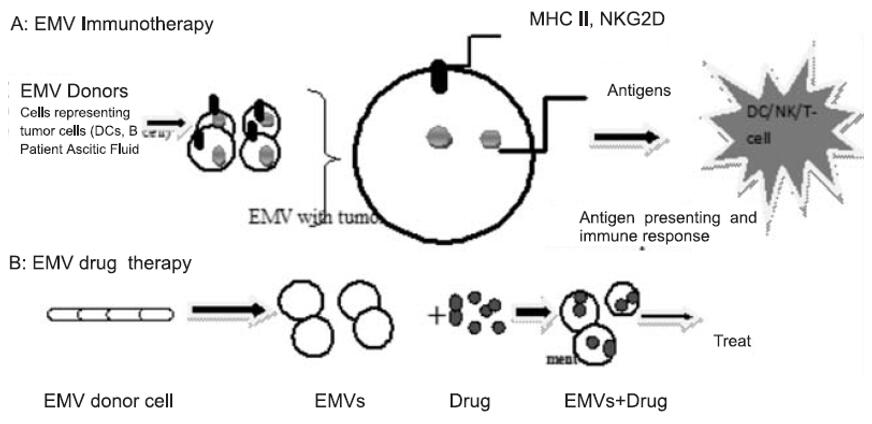Exosome Applications
The physiological characteristics of exosomes has endowed them special function as biomarkers, therapy targets and drug carriers. Creative Biostructure provides a comprehensive platform to help our client to expand the usage of exosome engineering for a specific diagnostic and therapeutic purpose.
Exosomes as Diagnostic Biomarkers
Exosomes are membrane vesicles secreted by all types of cells and are also discovered in the body fluids such as: saliva, blood, urine and breast milk. Exosomes are unique because its protein, lipid, RNAs contents provide additional hint for their identification. Therefore, exosomes have been considered as accessible diagnostic biomarkers with great potential for detection of many pathological conditions, including cancer.
Identification and quantitation of exosomes as well as its proteins, lipids, RNAs contents become useful tools for diagnostic purposes. More than 4400 different proteins have been identified to be associated with exosomes by mass spectrophotometer. Besides, exosomes are also enriched with different lipids like cholesterol, sphingolipids, phosphoglycerides, ceramides, etc. To detect disease in early stages, the PCR of miRNA is a new promising approach to detect RNA in patients’ serum.
Exosomes as Therapeutic Target
Given the fact that elevated exosome levels are often correlated with greater severity of different types of cancer, reducing circulating exosomes to normal levels is one of therapeutic strategies to increase treatment efficacy. There are different approaches to modulate exosome production: 1) Inhibition of exosome formation: inhibit crucial proteins involved in exosome formation pathway; 2) Inhibition of exosome release: inhibit important regulators of exosome release process, increased intracellular Ca2+, change cellular microenvironmental pH; 3) Inhibition of exosome uptake: add proteinase for surface proteins on exosomes may serve as receptors for uptake pathways. In addition to control exosomes production, removal of exosomes from the entire circulatory system might be a novel strategy for cancer treatment.
Exosomes could also be used as cancer immunotherapy becasue tumor-derived exosomes carry antigens that is a great source of specific stimulus for the immune response against tumors. Both tumor-derived and dendritic cell-derived exosomes have showed capability to stimulate tumor antigen-specific responses in experimental animal models and human clinical trials.
 Figure 1. Extracellular membrane vesicle therapy (EMVs) A: EMV immunotherapy. Tumor antigen on the membrane surface from different sources was introduced in vivo to elicit targeted immune responses. B: EMV drug therapy. Drug packaged into/onto EMVs isolated from donor cells to minimize degradation and increase delivery to intended sites (Hegmans J.P., et al.: Am. J. Pathol. 164, 1807 (2004).)
Figure 1. Extracellular membrane vesicle therapy (EMVs) A: EMV immunotherapy. Tumor antigen on the membrane surface from different sources was introduced in vivo to elicit targeted immune responses. B: EMV drug therapy. Drug packaged into/onto EMVs isolated from donor cells to minimize degradation and increase delivery to intended sites (Hegmans J.P., et al.: Am. J. Pathol. 164, 1807 (2004).)
Exosomes as Targeted Drug Delivery Vehicles
Exosomes became one of the most common methods applied in drug delivery system because of several advantages they have. Firstly, exosomes normally have a small size 40-100 nm, which is more homogenous compared to other microvesicles. This will lead them to evade rapid clearance by the mononuclear phagocyte and enhances passage through fenestrations in the vessel wall. Secondly, due to their endogenous origin, they are less toxic for and better tolerated by the immune system. It facilitates them to avoid causing side effects that normally occur with synthetic nanoparticles. Additionally, the specific ligand or protein expressed on the exosome surface increases efficiency of cargo into the cytosol of the target cell, and therefore fewer off-target effects. Exosomes are generally found most useful as a drug delivery medium in cancer therapy, anti-inflammation and gene interference therapy such as transferring of miRNA.
There are different kinds of cargos encapsulated by exosomes, especially like siRNA or miRNA. The delivery of RNA is attracting because they are rapid degradation in cell circulation and have the limitation in passing through the membrane and in cellular uptake. Chemotherapeutics loaded into exosomes is also used for cancer therapy such as doxorubicin. In principle, there are four key components to achieve correct functionality and efficacy during exosomes drug delivery:1) Choosing the donor cell type to produce drug-carrying exosomes; 2) Using correspond methods to encapsulate the exosomes cargo; 3) Enhancing the specificity of cargo delivery by targeting peptides on the surface of the exosomes; 4) Administrating exosomes to target the area of disease.
Based on our comprehensive knowledge of exosomes, Creative Biostructure offers top services to satisfy your demands on exosome applications. Please contact us for more information.
Ordering Process
References
- Hegmans J.P., et al. (2004) Proteomic analysis of exosomes secreted by human mesothelioma cells.: Am. J. Pathol. 164, 1807.
- Qin, Jun., and Xu, Qing. (2014) Functions and applications of exosomes. Drug Research, Vol. 71 No. 4 pp. 537-543.
- Rashed, M. H., et al. (2017) Exosomes: from garbage bins to promising therapeutic targets. Int J Mol Sci. 18(3): 538.
- Yamashita, T., et al. (2018) Possibility of exosome-based therapeutics and challenges in production of exosomes eligible for therapeutic application. Biol Pharm Bull. 41(6):835-842.

